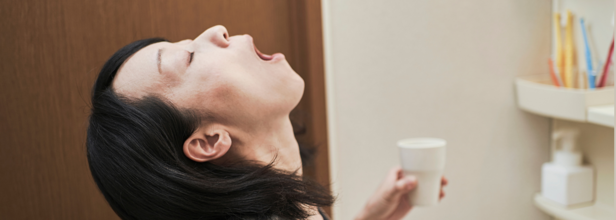- Health Conditions A-Z
- Health & Wellness
- Nutrition
- Fitness
- Health News
- Ayurveda
- Videos
- Medicine A-Z
- Parenting
- Web Stories
How To Clear Mucus From Your Throat- Top Home Remedies For Relief

How To Clear Mucus From Your Throat- Top Home Remedies For Relief
It's the feeling we all have experienced at some point: that stubborn lump in your throat. You don't really know how the phlegm got there, but it's annoying, persistent, and clearing it seems like a gross chore. Whether it's the result of a cold, allergies, or something else, you know it's there, and it's uncomfortable. But before you go into full panic mode, it's important to understand that mucus has a purpose-it's helping protect your respiratory system. Now, let's dive into what you can do to clear it out and get back to feeling like yourself.
What Is Mucus and Why Does Your Body Produce It?
Mucus, or phlegm when produced in excess, is your body's defense mechanism. It’s made up of water, salt, and antibodies and serves as a protective layer that captures unwanted microorganisms, including bacteria, allergens, and dust. Even when you’re feeling fine, your body naturally produces about a quart of phlegm each day to prevent these harmful elements from entering your lungs. But when you’re sick or battling allergies, your body ramps up mucus production to trap and clear out these invaders.
Mucus is produced in the nose and lower airways as a response to inflammation. It's secreted by mucous membranes that run from the nose down to the lungs. In excess, it is coughed up as phlegm, which can be very uncomfortable and even irritating, especially if settled in your throat.
Common Causes of Mucus in the Throat
Several factors contribute to excess mucus buildup:
1. Acid Reflux and GERD
When stomach acid flows up into your throat, it irritates the mucous membranes and causes an increase in mucus production.
2. Allergies and Sinusitis
Pollen, dust, and other allergens can cause your body to produce more mucus to trap and expel these irritants.
3. Respiratory Infections
Colds, flu, or sinus infections can cause mucus to thicken, making it hard to clear from your throat.
4. Asthma and Chronic Respiratory Diseases
Conditions such as asthma or chronic bronchitis cause inflammation in the airways, increasing mucus production.
5. Smoking and Environmental Irritants
Cigarette smoke and pollution can irritate the lungs, leading to excess mucus production as your body tries to expel these harmful particles.
Environmental and Lifestyle Factors Contributing to Mucus Buildup
1. Dry Air
A dry indoor environment can make your throat feel dry, which encourages the body to produce more mucus in an attempt to lubricate and protect the airways. Using a humidifier can help relieve this.
2. Dehydration
Failure to hydrate will cause mucus to thicken and become sticky, thus hard to clear. It is important to hydrate to thin mucus and ease its expulsion.
3. Overconsumption of Dehydrating Beverages
Beverages like coffee, tea, and alcohol will contribute to dehydration, which means you will also have increased mucus production that will not be easy to expel.
4. Medication
Some drugs, like ACE inhibitors or birth control pills, will cause overproduction of mucus. Consult your doctor if you suspect that this is one of the contributing factors.
Natural Remedies for Mucus Removal in the Throat
There are several effective ways of clearing mucus in the throat naturally.
1. Honey in Hot Drinks
Honey soothes the throat and can help in reducing the thickness of the mucus, thus easing the expulsion. It has also antibacterial properties that help strengthen the immune system.
Note: Honey is not safe for children under 1 year old.
2. Herbal Remedies
Some herbs such as eucalyptus, thyme, and ivy extract may help in the clearance of airways. Before you use any herb, make sure to consult your doctor.
3. Hot Soup
Warm liquids, such as chicken soup, can keep you hydrated and thin out the mucus in your throat so that it can be expelled.
4. Humidifier
Humidifier puts moisture in the air so that the throat is not dry, and mucus will not be so thick.
5. Refrain from Smoking and Airway Irritants
Cigarette smoke and other pollutants can worsen mucus production. Quitting smoking and minimizing exposure to pollutants can significantly improve mucus clearance.
Why Drinking Water is Important?
Staying hydrated is one of the best ways to manage mucus. Water helps thin mucus, making it easier for your body to expel. Aim to drink plenty of fluids, especially if you’re dealing with a cold or allergies.
What to Avoid
Drinks such as caffeinated beverages and alcohol can dehydrate you, thickening mucus and making it harder to clear.
When to Seek Medical Attention for Mucus Buildup
Most mucus buildup can be cleared with home remedies, but there are times when you should consult with a doctor:
1. Persistent Symptoms
If the mucus doesn’t clear after several days or keeps coming back, it may be a sign of an underlying condition that requires medical intervention.
2. Coughing Up Green or Yellow Mucus
If your mucus turns green or yellow, this could indicate a bacterial infection. See a healthcare provider if you’re coughing up large amounts of colored mucus.
3. Blood in Mucus
Blood in your mucus may indicate a serious problem like a lung infection or other breathing condition. Seek medical help right away.
4. Pain or Tightness in the Chest or Breathing
Difficulty breathing or tightness in the chest or sharp pain when coughing could be symptoms of a more serious lung disease and should be seen by a healthcare provider.
Your Body Pain Has a Pattern: Expert Reveals What It Really Means

(Credit- Canva)
Sometimes body pain can be quite difficult to figure out. ‘Is it my shoulder muscle, or is it shoulder joint that’s causing me pain?’ We have all had these questions and struggled while answering them at the doctor’s office. This is a common experience that we all go through, and it can make things like finding what medication will help elevate the pain difficult.
So how do doctors figure this out? Explaining this in a video, Dr Pooja Chopra MD, shares a post on Instagram. Posted on 8th September, in the video caption Dr Chopra explained, “As a PM&R and Pain specialist, my first job is to be a detective. Tracing pain back to its precise source is the most critical step, because each source requires a completely different treatment plan.” She further goes on to give a simplified guide to help people understand their pain better. Understanding where the pain comes from can help people feel more at ease as well as figure out how serious the problem could be.
How To Tell Whether Your Muscle Is Causing Pain, Your Joint Or Nerve?
Muscle Pain
Muscle pain, also called myofascial pain, feels like a dull, deep ache. When you press on the sore spot, you'll feel tenderness and might even find what feel like tight knots or bands. This kind of pain gets worse when you use the muscle that's hurt, but it often feels better with simple things like resting, putting a heating pad on it, or doing some gentle stretches. You can usually point with one finger to exactly where it hurts.
Joint Pain
Joint pain, or articular pain, is a deep, internal ache that feels very stiff. It's not on the surface; it feels like it's coming from inside the joint itself. You might feel a sharp pain when you make a specific movement, like reaching high above your head. This type of pain is often at its worst when you first wake up in the morning, but it tends to get better as you start moving around and warm up the joint. Because the pain is deep, it can be hard to say exactly where it is.
Nerve Pain
Nerve pain, also known as neuropathic pain, is the most distinct kind of pain. It feels like sharp, shooting, burning, or "electric" shocks. People often describe it as a tingling sensation, like "pins and needles," or even numbness. A key sign of nerve pain is that it travels along a clear path, for example, from your neck all the way down your arm. This pain can come on unexpectedly, even when you're completely still and not moving the body part.
It's important to remember that these types of pain can be linked. For example, a problem with a joint could make the muscles around it tense up in a protective spasm, which could then pinch a nearby nerve. This is why a proper diagnosis from a specialist is so important. They use advanced tools like diagnostic ultrasound, which lets them see exactly what's happening inside your body, so they can treat the root cause of the pain precisely.
Chronic Insomnia Could Increase The Risk Of Dementia By 40%: Study

A new study has pointed out that people who have chronic insomnia could be at higher risk of dementia. One of the best things a person can do to recover from a tiring day, whether it is from a stressful day or after a tiring workout. However, it is not easy for everyone, there are many people who suffer with sleep problems like chronic insomnia.
An estimate of 16.2% of people around the globe suffer with insomnia according to 2025 Sleep Medicine Reviews, which is a condition that makes it hard to fall or stay asleep. A big number of these people have what's called chronic insomnia, meaning they've had this problem for at least three months, with poor sleep happening three or more nights a week.
Previous studies have already connected insomnia to serious health problems like heart disease and diabetes. But now, a new study in the medical journal Neurology has found an even more concerning link: people with chronic insomnia might be at a much higher risk for developing dementia and other memory problems. The study suggests that their brains could be aging faster as a result.
How Does Insomnia Cause Dementia?
For this study, researchers followed 2,750 older adults for an average of five and a half years. At the beginning, everyone was mentally healthy. The researchers found that the people who had chronic insomnia had a 40% higher chance of developing dementia or mild cognitive impairment (MCI).
Researchers explain that this is a huge finding because it means chronic insomnia could be a bigger risk factor for memory loss than having both high blood pressure and diabetes. They also discovered that those who slept less had more of the tell-tale signs of Alzheimer's disease in their brains, like amyloid plaques, and other signs of damage to their brain's blood vessels. This shows that poor sleep isn't just about feeling tired—it's linked to real, physical changes in the brain.
Why You Should Prioritize Sleep?
Experts believe that a big part of the problem is that insomnia is often overlooked. Many older adults just assume that bad sleep is a normal part of getting older. However, doctors stress that chronic insomnia is a real medical issue that goes beyond typical age-related changes. They urge doctors to start talking to their patients about their sleep habits during every check-up.
The good news is that chronic insomnia is a treatable condition. The main treatment is a type of talk therapy called Cognitive Behavioral Therapy for Insomnia (CBT-I). The hope is that by recognizing and treating insomnia, doctors can help protect a person's brain health for years to come.
How Does Insomnia Affect Our Memory
Previous studies have shown that our cognitive abilities are affected by how much we sleep. A 2020 study published in the Journal of Neuroinflammation, explained that there is a strong connection between a person's sleep and their risk of developing Alzheimer's. We know that sleep is crucial for learning and creating memories. Studies have found that a lack of sleep and conditions like insomnia are not just a symptom of Alzheimer's—they may also play a role in its development.
This means that sleep disorders can have a significant impact on whether someone gets Alzheimer's and how fast the disease progresses. Because of this, it's important for doctors to pay more attention to sleep issues when diagnosing and treating patients. By properly screening for and managing sleep disorders, we might be able to help prevent or slow down the progression of Alzheimer's disease.
Daylights Savings Time May Be Causing You Higher Risk Of Heart Attacks And Obesity, Study Backs Fixed Standard Time

A new study from Stanford University suggests that daylight saving time isn't just an inconvenience; it could actually be bad for our health. The research shows that our twice-a-year routine of changing the clocks disrupts our bodies' natural rhythms, which can lead to serious health issues. This is a big deal because it provides the first real scientific evidence that this time-switching practice has a biological cost.
What is Daylight Saving Time?
According to the Sleep Foundation, daylight saving time (DST) has been an official practice in most of the United States since 1966. Only a few places, like Hawaii and parts of Arizona, don't follow it. The routine is simple: on the second Sunday in March, we set our clocks forward by one hour, losing an hour of sleep. Then, on the first Sunday in November, we set them back, gaining that hour of sleep. This is why many people remember it as "Spring Forward, Fall Back."
How Daylights Saving Time Affects Our Health
According to the study, if the U.S. got rid of daylight saving time and stayed on standard time all year, it could prevent thousands of strokes and significantly reduce obesity. The researchers, using mathematical models and data, estimated that this single change could prevent 300,000 strokes and lead to 2.6 million fewer people with obesity every year. This adds to what we already know about the negative effects of the time change, such as a spike in heart attacks and car crashes in the days after we lose an hour of sleep in the spring.
How Does Daylight Saving Time Affect Sleep?
Our body's internal clock is heavily influenced by light. When the clocks change, the amount of natural light we get in the morning and evening shifts. This can throw off our sleep-wake cycle, making it harder to feel alert in the morning and sleepy at night.
The “spring forward” change is particularly hard on us. One study found that on the Monday after the time change, the average person gets 40 minutes less sleep. This lack of sleep can build up over time, affecting our mood and increasing the risk of accidents.
While the "fall back" change in November can give us an extra hour of sleep, some people still struggle to adjust to the new schedule. For most people, the effects fade after a few days, but some studies suggest that others never fully adjust, leading to ongoing health problems.
Why Time Changes Mess With Our Bodies
The core problem lies in our body's internal clock, or circadian rhythm. Think of it as the conductor of an orchestra, directing all your body's processes. When it's working well, everything is in sync. But when it's thrown off, like by getting light at the wrong time of day, your body's systems can become disorganized.
This can weaken your immune system, mess with your sleep, and increase your risk for diseases like stroke and obesity. The study found that switching between standard and daylight saving time is the worst thing we can do for our body clock, much worse than staying on either time year-round. It's a bit like having the conductor suddenly change the tempo for no reason—the whole orchestra, or in this case, your body, gets thrown off.
© 2024 Bennett, Coleman & Company Limited

